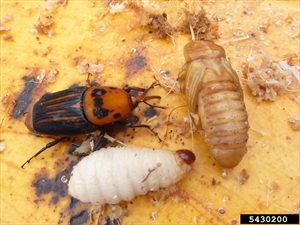Red palm weevil; also known as the Asian palm weevil or sago palm weevil.
Pacific Pests, Pathogens, Weeds & Pesticides - Online edition
Pacific Pests, Pathogens, Weeds & Pesticides
Coconut red palm weevil (180)
Rhyncophorus ferrugineus
Asia, Middle East, North Africa, the Caribbean, Europe, Oceania. It is recorded from Papua New Guinea, Samoa, Solomon Islands, and Vanuatu. Note, this pest has spread extensively in the Middle East and Europe in the last 30 years.
Coconut, and other palms: betel nut, oil palm, sago palm, date palm, and ornamental palms.
Symptoms include: holes at the base, tunneling in the stem or base of the fronds, leaves with straight edges rather than pointed tips, frass at the entrance of tunnels, wilting and death of the leaves, especially at the crown. However, the larvae and adults often destroy the inside of the palm without signs of infestation unless there is major damage. Palms can stand a lot of internal damage before symptoms become clear, but when the insides are hollowed out the palms collapse.
The adult is about 40 mm long and 15 mm wide, reddish-brown with dark spots on the part of the body behind the head, and they have a long snout, characteristic of weevils. They vary greatly in colour. The life cycle is about 4 months (Diagram). The female lays 200-300 whitish, smooth eggs (3 mm by 1 mm) in separate holes in the trunk or in petioles (leaf stalks). They are also laid in wounds caused by the rhinoceros beetle.
The eggs hatch in 2-5 days. The larvae are legless, white with a brown head, growing up to 50 mm long. They bore into the interior of the palm feeding on the soft tissue, but leaving the fibrous material. As the palms age they are found closer to the crown. At about 15 years they are found just below the crown, or in the crown and petiole bases.
After 1-3 months the larvae pupate, making fibrous cocoons in leaf litter at the base of the palm. Adult weevils emerge 2-3 weeks later. The adult weevil is a strong flier.
The weevil is a major pest of date palms, as well as coconut, oil palm, and sago palm. It also attacks a wide range of ornamental palms. The damage is done by the adult and larvae (grubs) boring into the soft inside of palms as well as feeding on the leaves. The larvae can make tunnels up to a metre long. Part of the economic importance of this pest is the cost of removing infested palms and replanting; there are also major costs involved in trying to cure infested palms.
On coconuts, look for holes in the crown or trunk through which stem fibres are ejected from the tunnels. There may be liquid oozing from the holes. But generally, it is difficult to detect the early stages of infestation. Pheromone traps and listening devices are needed. Put your ear to the trunk and listen for crunching noises as the larvae feed. Look for wilted leaves in the crown.
NATURAL ENEMIES
In the 1970s, Platymerus laevicollis (also known as the red-eyed assassin bug) was introduced into Sri Lanka from Samoa, but this predatory bug is a generalist feeding on a wide range of other insects. It was hoped that it would control rhinoceros beetles (Oryctes rhinoceros) in coconut plantations in Sri Lanka, but it was found to prefer the red palm weevil.
Nymphs and adult earwigs, Chelisoches moio, eat the eggs and larvae of the weevil.
CULTURAL CONTROL
- Destroy any infested stems by cutting and burying them, and treat cuts and other types of wounds with an insecticide.
- If leaves are removed from the palms during routine harvests (e.g., oil palm, date palm, sago palm) cut the leaves where the leaflets start, to prevent the weevil from entering the stem.
CHEMICAL CONTROL
Pheromone lures are available, and are used in date plantations in the Middle East, and in coconuts in India. The aggregation pheromone is marketed under the name Ferrolur and Ferrolure+. Commonly, bucket traps are baited with sugarcane.
A number of chemicals have been suggested as trunk injections, such as fipronil and imidacloprid, but these are unlikely to be economic in coconut plantations. Note, there are also restrictions on the use of these insecticides in many countries.
____________________
When using a pesticide, always wear protective clothing and follow the instructions on the product label, such as dosage, timing of application, and pre-harvest interval. Recommendations will vary with the crop and system of cultivation. Expert advice on the most appropriate pesticides to use should always be sought from local agricultural authorities.
AUTHOR Grahame Jackson
Information from Rhode BE, Crosby T (2012) Red Palm Weevil (Rhynchophorus ferrugineus): PaDIL - http://www.padil.gov.au; and McCaffrey, S, Walker K (2012) Red palm weevil (Rhynchophorus ferrugineus): PaDIL - http://www.padil.gov.au; and Rhynchophorus ferrugineus (red palm weevil) (2020) Crop Protection Compendium. (https://www.cabi.org/cpc/datasheet/47472); and from Malumphy C, Moran H (2017) Red palm weevil Rhynchophorus ferrugineus. Plant Pest Factsheet. Department for Environment, Food & Rural Affairs. (https://planthealthportal.defra.gov.uk/assets/factsheets/Rhynchophorus-ferrugineus-Defra-PP-Factsheet-Oct-2016-FINAL4.pdf). Photo 1 John Kabashima, UC Cooperative Extension, Bugwood.org. Photos 2&3 Christina Hoddle, University of California - Riverside, Bugwood.org. Photo 4 Küchenkraut Rhynchophorus ferrugineus (2021) Wikipedia. (https://en.wikipedia.org/wiki/Rhynchophorus_ferrugineus/).
Produced with support from the Australian Centre for International Agricultural Research under project PC/2010/090: Strengthening integrated crop management research in the Pacific Islands in support of sustainable intensification of high-value crop production, implemented by the University of Queensland and the Secretariat of the Pacific Community.







